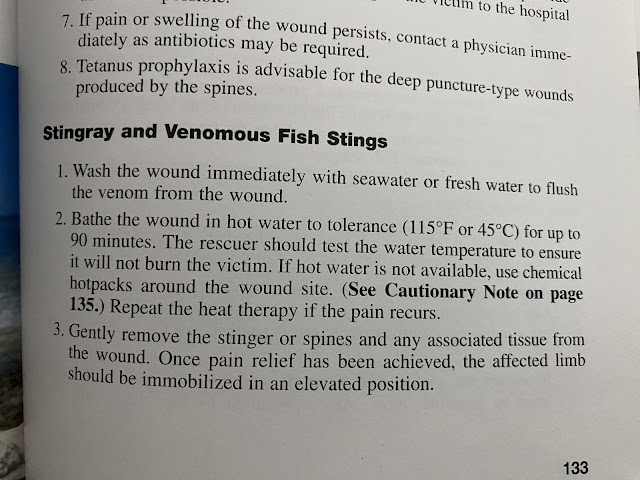Diamond Stingray, Hypanus dipterura
 Sting Ray stings SUCK. They are extremely painful and can be difficult to manage. The bone that makes the stinger can break off and create further complications for healing. Pain, infection, and if you are in Mexico, you are probably a good hike from the car and a drive to medical attention. Do you know where the medical clinic is? I’ve been stung twice, each time I thought I knew to take precautions and obviously I failed. Chances are, I may get stung again. Knowing that they are there, even if you can’t see them is the first thing or layer to Sting Ray jab prevention.
Sting Ray stings SUCK. They are extremely painful and can be difficult to manage. The bone that makes the stinger can break off and create further complications for healing. Pain, infection, and if you are in Mexico, you are probably a good hike from the car and a drive to medical attention. Do you know where the medical clinic is? I’ve been stung twice, each time I thought I knew to take precautions and obviously I failed. Chances are, I may get stung again. Knowing that they are there, even if you can’t see them is the first thing or layer to Sting Ray jab prevention. The last time I was stung I was wearing saltwater wading booties and the sting went straight through the top of the boot. There are spats you can wear, the kind similar to rattlesnake protection but I’m not going to wear them. I like prevention, like depending on good driving instead of relying on seatbelts. Yes seatbelts are good but good driving habits are best.
Shuffling your feet is MANDATORY. Sting Rays flap their body and burry themselves in the sand. Sometimes you can’t even see them. Anytime you enter the water, do the Sting Ray shuffle.
Springtime seems to be the time I see them most. It’s also one of my favorite times to fish. The tide swing in the Sea of Cortez is huge in the spring, up to thirty vertical feet and it fills in quick.
If you are stung there are two basic ways to treat the jab.
At the time of my first sting, from my experience working in surgery, I did a pain block on myself right there in the tidal flats of De Marua estuary. The same block they would give you at the Red Cross Clinica. I worked as an anesthesia assistant and I assisted with pain prevention as my job every day. I was trained extensively to perform the necessary skill in order to block the pain. It was springtime and I was hiked way out on a big tide swing. I had waded out onto a sand flat and got excited about spotting fish, forgot to shuffle and stepped on a small ray.
Boom!
Gottam mother f cker!,, immediately instant pain and blood puffing out my boot tainting the water.
I was so scared as the tide was rising nearly an inch per minute and I was a couple of hundred yards from higher ground. Hopping to dry sand, I managed to assess the wound, disinfect it, draw up the medication and inject the local to completely block the pain. I was so scared of passing out and possibly drowning in just a few minutes. I cast a couple of times after but it was useless, I was done, completely drained of the desire to fish. I went into town and ordered drinks.
I knew the pain from a sting lasts a few hours. It is excruciating but it was like it didn’t happen minus the puncture wound bleeding.
I had highly specialized training, performed the same pain block daily and specific medication kit with me and it was still a big deal as I’m terrible at taking care of myself.
The whole thing just ruined my trip.
The next time I was barefoot hanging with my family on the beach and just a few yards in the water and BANG!
No kit.
At this time, I had more information on how to treat the jab, HOT WATER. Hot as you can stand and soak the wound for hours. It still hurts like tearful crying hurt but it eases up with the hot water as the temperature denatures the proteins that get into your nerve pathway.
Hot water soak.
No meat tenderizer, don’t piss on it. Clean it, inspect for a broken off stinger and soak in hot water.
Better yet, shuffle.
The below pics are from the book: Venomous & Toxic Marine Life of the World









